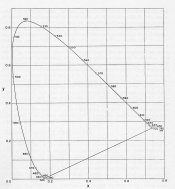I am thinking spectrum. Contained in that spectrum are the Additive and Subtractive colors which behave differently when viewed by transmission or reflection.
Since we are talking about film here, and not a spectrum, a film is "tri color", even a B&W film.
A sharp cutting Wratten blue filter does not pass green light. And, a blue sensitized film does not see green light. If you add something to the blue sensitive film to see green then it is ortho. How much green it sees depends on the amount of additive present. If you are giving this film a WR blue filtered exposure however, you will not see any change in sensitivity. If you give it a WR green exposure you will see an increase in sensitivity.
Since magenta is a combination of Blue and Red at opposite ends of the spectrum, it falls off the norm and is not easily represented on CIE charts or by other methods of describing color other than by being anti-green. Of course we see it. Just as we see yellow which is a combination of Red and Green.
PE
I'm sorry, but it doesn't make much sense to talk about additive and subtractive colours when discussing what filter filters out what part of the spectrum.
We have seen that it opens easy-to-fall-into trapdoors to do so anyway, in the post that suggested that magenta is passed on by a blue filter.
If you look at spectral sensitivity graphs of B&W emulsions (and you know all this), that are produced by exposing said emulsions to white light turned into spectra by a wedge, the resulting densities (after processing of course) do not show a tri-colour behaviour. Not that the resulting curves are flat. But it's not a discrete, tri-colour affair.
So it's not correct to even suggest that B&W films are tri-colour.
More to the point, however, is that if you compare such spectral sensitivity photos, it's clear to see that panchromatic films react to a part of the spectrum that orthochromatic films do not register (ortho's sensitivity stops just short of 600 nm, while pan emulsions go on to about 680 nm).
All we have to do to get an orthochromatic response out of a panchromatic film is to block that 'extra' part of the spectrum. Is that possible, and do such filters exist? Why, yes of course!
Now we can argue about what colour that filter would be for ages, i'm sure.
But it's not more difficult than that.

Yellow, by the way, is
not "a combination of Red and Green"! It's a pure spectral colour.
You're still caught in the wrong frame of reference!















